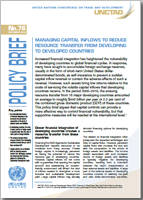
Increased financial integration has heightened the vulnerability of developing countries to global financial cycles.
In response, many have sought to accumulate foreign exchange reserves, usually in the form of short-term United States dollardenominated bonds, as self-insurance to prevent a sudden capital inflow reversal or contain the adverse effects of such a reversal. However, such assets bring low returns relative to the costs of servicing the volatile capital inflows that developing countries receive.
In the period 2000–2018, the ensuing resource transfer from 16 major developing countries amounted on average to roughly $440 billion per year or 2.2 per cent of the combined gross domestic product (GDP) of these countries.
This policy brief argues that capital controls can provide a more effective way to control financial vulnerability, but that supportive measures will be needed at the international level.
Key points:
-
An underestimated feature of financial integration is the increased size and altered composition of the stock of external assets and liabilities.
-
In developing countries, the rates of return earned on foreign assets is typically lower than the rates of return paid on foreign liabilities.
-
The ensuing average annual resource transfer from developing countries exceeds two per cent of their combined GDP.
-
Capital controls can be effective tools for reducing resource transfer from developing countries and enhancing their financing options for achieving the Sustainable Development Goals.



